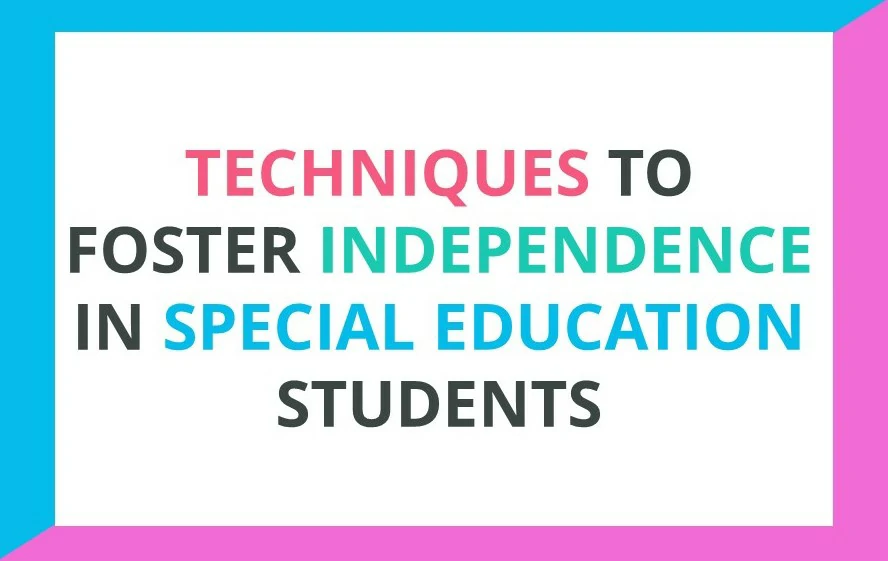Fostering independence in special education students is crucial for their overall development, helping them acquire essential life skills and gain autonomy. This article provides effective techniques for teachers to support their students in progressing toward independence. These strategies can be implemented in different classroom settings and tailored to meet individual student needs, promoting long-term success and integration into society.
Table of Contents
1. Set Realistic and Gradual Goals
Setting realistic, specific, and achievable goals is key to fostering independence in special education. Break down larger goals into smaller, manageable steps to help students progress gradually. For example, to help a student become independent in a task like getting dressed, break the task into smaller steps: choosing clothes, putting on a t-shirt, then pants, and so on. This step-by-step approach promotes steady progress and builds confidence. It is essential to celebrate each small achievement along the way to keep students motivated and help them see their own progress.
Another effective technique is to use visual timelines that show each step of the goal, giving students a clear picture of the journey ahead. This helps reduce anxiety and allows them to take ownership of their progress. Regularly revisiting goals and adjusting them based on student progress ensures that the targets remain challenging yet attainable.
2. Use Visual Supports for Better Understanding
Visual supports such as pictograms, diagrams, or illustrated sequences are powerful tools in special education. They help students understand and follow the steps of a task. For instance, using a sequence chart to demonstrate handwashing steps can help students visualize expectations and complete tasks independently. Visual aids simplify complex processes, making them easier for students to follow and master on their own.
Incorporating technology, such as tablets or interactive whiteboards, can enhance visual support by providing dynamic and engaging representations of tasks. Video modeling is another valuable technique, where students watch videos of others completing tasks before trying them themselves. This approach can be particularly effective for students who benefit from seeing a model perform each step.
3. Encourage Decision-Making to Build Autonomy
Encouraging students to make choices in daily situations is an effective way to build independence. Allowing students to choose between two activities or two snack options helps them develop a sense of control and responsibility. Decision-making, even in small matters, fosters autonomy and boosts students’ confidence in their abilities.
To further support decision-making, offer opportunities for students to participate in classroom planning. For example, allow them to choose themes for lessons, decide on group activities, or select materials for a project. Providing structured choices helps students practice decision-making in a safe environment, which can lead to greater confidence in more significant situations.
4. Implement Consistent Routines for Independence
Consistency is essential in fostering independence. Create predictable routines that students can follow daily, whether in the classroom or at home. Classroom routines, such as putting away belongings upon arrival, and personal routines, like preparing for a meal, provide structure and predictability. The more familiar students become with a routine, the more likely they are to perform it independently.
To strengthen the impact of routines, consider using visual schedules that outline the daily activities. Visual schedules help students anticipate upcoming tasks and transitions, reducing anxiety and promoting a sense of security. In addition, using timers or countdowns can help students manage time effectively, allowing them to transition between activities more smoothly.
5. Provide Encouragement and Positive Reinforcement
Celebrating successes, no matter how small, is crucial for maintaining motivation. Use positive reinforcement such as verbal praise or reward systems to encourage students. For instance, when a student successfully completes a step independently, offer a compliment or a reward, like a star on a progress chart. Positive reinforcement reinforces desired behaviors and motivates students to continue striving for independence.
Consider developing individualized reinforcement plans that align with each student’s preferences. Some students may respond well to tangible rewards like stickers or small treats, while others may find verbal praise or extra playtime more motivating. It is essential to understand what works best for each student to provide the most effective reinforcement.
6. Promote Problem-Solving Skills
Teaching problem-solving skills is a fundamental aspect of fostering independence. Encourage students to solve problems by asking open-ended questions that prompt them to find solutions. For example, if a student cannot find an item, ask where they might look instead of providing the answer. This approach builds confidence and encourages students to tackle challenges independently.
Providing scenarios that require problem-solving, such as puzzles or real-life situations, can help students practice these skills in a controlled environment. Role-playing activities can also be beneficial, as they allow students to experience different situations and think through potential solutions. These experiences build resilience and adaptability, which are crucial for independent living.
7. Gradually Reduce Support as Skills Improve
Gradually reducing support as students develop skills is essential for fostering independence. Start by modeling the task, then move to physical or verbal support, and finally allow the student to complete the task on their own. This gradual reduction of assistance enables students to gain confidence and competence, ultimately helping them feel capable of handling tasks independently.
It is important to closely monitor each student’s progress and adjust the level of support as needed. Documenting progress through observation notes or video recordings can provide valuable insights into when to reduce support. Encouraging self-assessment can also empower students to recognize their achievements and understand areas where they need less help.
Conclusion
These techniques can be adapted to the individual needs of each student, promoting gradual and sustainable progress toward independence. Fostering independence in special education students is crucial for helping them integrate into society and live as autonomously as possible. By setting realistic goals, using visual supports, encouraging decision-making, implementing consistent routines, promoting problem-solving skills, and gradually reducing assistance, teachers can help students achieve a greater level of self-sufficiency.
Ultimately, fostering independence is not only about teaching students specific skills but also about instilling a sense of confidence and empowerment. With the right strategies and consistent support, special education students can overcome challenges and achieve meaningful milestones, leading to a more independent and fulfilling life.






